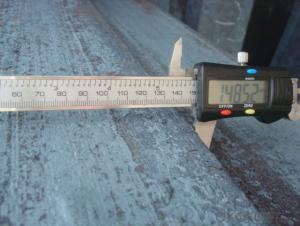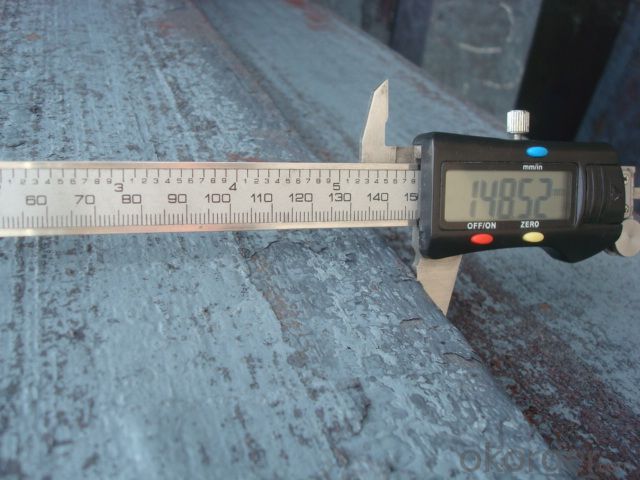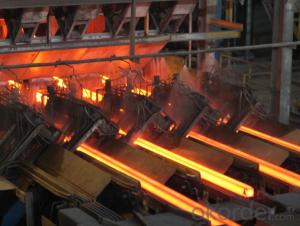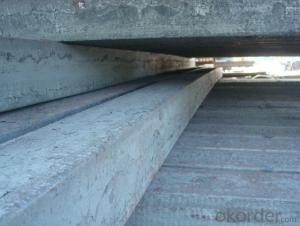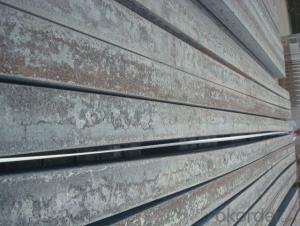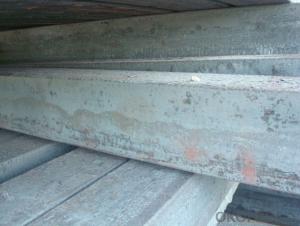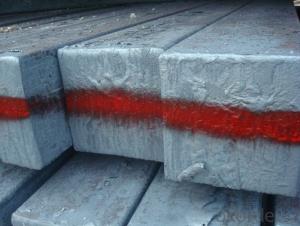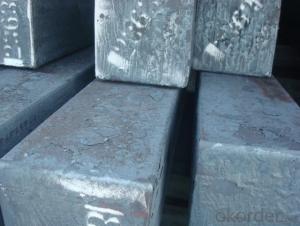Alloyed Continue Casting Steel Billet by Blast Furnace According to the Standard of YB2011-83
- Loading Port:
- Tianjin
- Payment Terms:
- TT OR LC
- Min Order Qty:
- 1000 m.t.
- Supply Capability:
- 100000 m.t./month
OKorder Service Pledge
OKorder Financial Service
You Might Also Like
Alloyed Continue Casting Steel Billet by Blast Furnace According to the Standard of YB2011-83
1.Structure of Alloyed Continue Casting Steel Billet by Blast Furnace According to the Standard of YB2011-83
Alloyed Continue Casting Steel Billet by Blast Furnace According to the Standard of YB2011-83 is the raw material of all kinds of steel mill. Billet section of square, round, flat, rectangular and abnormity, etc Several, mainly related to shape of rolled products. Simple rolled section steel, choose cross section of square billet or rectangular billet. rolling The sector products such as flat steel, Angle steel, select the rectangular billet or slab. Had better profiled billet when production beams, channels, and in rolling process Lines and improve the yield. The raw material of round billet is the production of seamless tube.
2.Main Features of Alloyed Continue Casting Steel Billet by Blast Furnace According to the Standard of YB2011-83
Steel Bloom Manufactured by Blast Furnace section size should meet the requirements of rolling deformation and finished product quality, but also roll strength and biting condition of restrictions. General steel Billet section height H. And the roll diameter D The ratio of the ( namely H/D) Should be less than or equal to zero 0.5 . Length of steel billet by finishing temperature, Rolling time and the length of the product Or times ruler. When heated too long accident prone to bump the furnace wall of steel, too short, furnace bottom utilization rate is not high, influence the heating furnace production. For the production Choose a variety of steel and steel billet, should consider the affinities of billet, as far as possible in order to improve the productivity of the roughing mill, simplify the stock management of workshop.
3. Alloyed Continue Casting Steel Billet by Blast Furnace According to the Standard of YB2011-83 Images
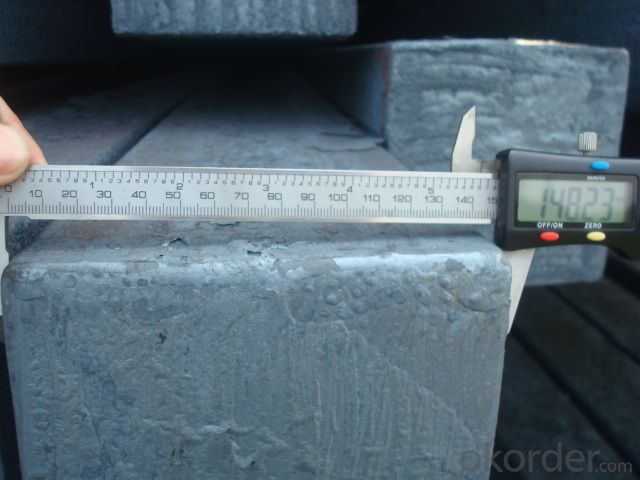
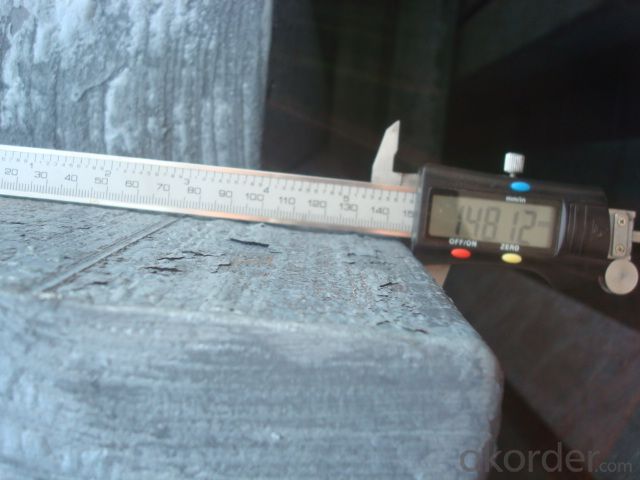
4. Alloyed Continue Casting Steel Billet by Blast Furnace According to the Standard of YB2011-83 Specification
Steel Bloom Manufactured by Blast Furnace rolled steel, after processing can be used for mechanical parts, forging parts, processing all kinds of steel, steel Q345B channel steel, wire rod is the role of the billet. Steel billet is used in the production of semi-finished products, generally cannot be used directly for the society. Steel billets and steel are strictly divided into standard, cannot decide to whether the business enterprise of the final product, and according to unified standards to perform the whole society. Typically, billet and the steel is relatively easy to distinguish, but for some steel billet, and have the same specification and same steel purposes (such as rolling tube billet), whether can be used for other industries, whether through steel processing process, whether through a finished product rolling mill processing to distinguish
Material standard The editor Range of thickness: 150-240 - mm + / - 5 mm width range: 880-1530 - mm + / - 20 mm Length: 3700-10000 - mm + / - 500 - mm Cross-sectional size: 64 * 64; 82 * 82; 98 * 98; 124 * 124; 120 * 150; 152 * 164; 152 * 170 mm Length: 9000 mm Section of tolerance: billet: 1.0 + / - 2.0-1.0 + / - 1.0 mm slab: width: + / - 2.0 mm thickness: + / - 3.0 mm The length tolerance: + / - 200 mm Section diagonal tolerance: 3.5-8.0 MM Billet section size protrusions requirements: < 1242 mm, do not allow; > = 1242 mm, < = 2 mm 1242 mm, < = 3 mm Beheading (shear) extension deformation: < 1242 mm billet: no control; The slab: < = 15 mm Surface tilt: no more than billet section 0.1 Bending: every 1 m length is not more than 10 mm The distortion: length < = 5 m, < = 11. ; The length of the < = 7.5 M, < = 5. Material % 3 sp/PS chemical composition: C Mn Si S P
5.FAQ of Alloyed Continue Casting Steel Billet by Blast Furnace According to the Standard of YB2011-83
We have organized several common questions for our clients,may help you sincerely:
①How about your company?
A world class manufacturer & supplier of castings forging in carbon steel and alloy steel,is one of the large-scale professional investment casting production bases in China,consisting of both casting foundry forging and machining factory. Annually more than 8000 tons Precision casting and forging parts are exported to markets in Europe,America and Japan. OEM casting and forging service available according to customer’s requirements.
②How to guarantee the quality of the products?
Crack in continuous casting billet surface shall not be visible to the naked eye, overlapping, skull patch, or scarring, inclusion and depth
Height is greater than the
3 mm
Scratches, indentation, scratch, pores, wrinkles, cold splash, handle, bump, pits
And depth is greater than the
2 mm
The hairline.Casting billet cross-section can not have shrinkage cavity, subcutaneous bubble.
Crack in continuous casting billet surface shall not be visible to the naked eye, overlapping, skull patch, or scarring, inclusion and depth
Height is greater than the
3 mm
Scratches, indentation, scratch, pores, wrinkles, cold splash, handle, bump, pits
And depth is greater than the
2 mm
The hairline.Casting billet cross-section can not have shrinkage cavity, subcutaneous bubble.
③How to check the appearance?
Appearance standard 2.1And the difference between the lengths of the continuous casting billet in cross section of diagonal should conform to the table2The provisions of the. 2.2And the degree of curvature of continuous casting billet per meter shall not be greater than20 mm,The total bending shall not be greater than the total length2%. 2.3, casting billet are allowed drum belly, but height shall not exceed the casting billet length allowed is deviation. 2.4Oblique cutting, casting billet end shall not be greater than20 mm. 2.5Casting billet end caused by shear deformation, spread shall not be greater than the length10%. 2.6, casting billet can not have apparent reverse..
- Q: What are the potential applications of steel billets in the automotive aftermarket?
- The automotive aftermarket can benefit greatly from the wide variety of uses for steel billets. The strength, durability, and versatility of steel make it an ideal material for many applications. To begin with, steel billets are commonly used in the production of various automotive parts, such as engine components, transmission parts, suspension systems, and chassis components. These critical components require materials with high tensile strength and resistance to wear and tear, which steel billets can provide. In addition, steel billets can be utilized to create customized or aftermarket modifications for vehicles. This includes performance upgrades like engine tuning, exhaust systems, and suspension modifications. Thanks to its machinability, steel billets can be shaped and formed into precise shapes and sizes, resulting in improved performance and customization options. Furthermore, steel billets can be employed in the manufacturing of automotive tools and equipment used in the aftermarket. This encompasses tools like jacks, stands, wrenches, and other specialized equipment needed for repairs, maintenance, and modifications. The use of steel billets ensures that these tools are strong, durable, and capable of withstanding the challenging conditions of the automotive industry. Moreover, steel billets are also used in the production of aftermarket body parts and accessories. These can range from exterior components such as bumpers, grilles, and fenders, to interior accessories like shift knobs, pedals, and trim pieces. Steel billets can be shaped, welded, and finished to meet the desired specifications and aesthetics of the vehicle owner, creating a wide range of options for customization. Overall, steel billets have an extensive range of potential applications in the automotive aftermarket. From critical engine components to performance upgrades, tools, and body modifications, steel billets offer the necessary strength, durability, and versatility required in the automotive industry.
- Q: What are the different types of defects that can occur during casting of steel billets?
- During the casting of steel billets, several types of defects can occur, affecting the quality and integrity of the final product. Some common defects include: 1. Shrinkage: Shrinkage defects occur when the metal cools and solidifies unevenly, causing voids or shrinkage cavities in the billet. This can weaken the structure and reduce its overall strength. 2. Porosity: Porosity refers to the presence of trapped gas or air bubbles in the billet. It can occur due to improper gating or venting, inadequate control of the pouring temperature, or the presence of impurities in the molten metal. Porosity can reduce the billet's mechanical properties and make it more susceptible to failure. 3. Inclusions: Inclusions are non-metallic materials, such as oxides, sulfides, or refractory particles, that get trapped in the billet during casting. These inclusions can weaken the metal, leading to reduced ductility, increased brittleness, and decreased resistance to fatigue or corrosion. 4. Cold shuts: Cold shuts happen when two streams of molten metal fail to fuse properly during casting, resulting in a visible line or seam in the billet. Cold shuts can weaken the billet and cause it to fail under stress. 5. Hot tearing: Hot tearing occurs when the solidifying metal is restrained from contracting, leading to localized cracking or tearing. It usually happens due to high thermal stresses or inadequate feeding of the metal during solidification. Hot tearing can significantly affect the billet's structural integrity. 6. Misruns: Misruns are defects that occur when the molten metal fails to fill the entire mold cavity completely. This can happen due to inadequate pouring temperature, improper gating or venting, or insufficient fluidity of the metal. Misruns can result in incomplete, undersized, or malformed billets with reduced mechanical properties. 7. Surface defects: Surface defects include surface cracks, scabs, or surface roughness that can occur during the solidification or cooling process. These defects can lead to increased rejection rates, reduced machinability, and compromised surface finish of the billet. It is crucial to identify and minimize these defects during the casting process to ensure the production of high-quality steel billets with the desired mechanical properties and dimensional accuracy.
- Q: What are the different surface treatments for improved wear resistance in steel billets?
- There are several surface treatments that can be applied to steel billets to enhance their wear resistance. Some common methods include carburizing, nitriding, and hard chrome plating. Carburizing involves introducing carbon into the surface of the billet through a heating process, creating a hardened layer. Nitriding, on the other hand, involves introducing nitrogen into the surface to form a hard nitride layer. Hard chrome plating is another option where a layer of chromium is electroplated onto the surface, providing excellent wear resistance. These treatments can significantly improve the durability and performance of steel billets in various applications.
- Q: How do steel billets contribute to the manufacturing of tools and equipment?
- Steel billets are an integral component in the manufacturing of tools and equipment. These billets, which are essentially semi-finished steel products, play a crucial role in shaping and forming the final products used in various industries. Firstly, steel billets are used as raw material in the production of various types of tools and equipment. They serve as the starting point for manufacturing processes such as forging, rolling, and extrusion. These processes involve heating and shaping the steel billets to create the desired form and dimensions of the tools and equipment. Moreover, steel billets offer several advantages that make them suitable for tool and equipment manufacturing. The high strength and durability of steel make it an ideal material for tools that need to withstand heavy loads and harsh conditions. The versatility of steel allows for the production of a wide range of tools and equipment, including cutting tools, machine parts, construction equipment, and automotive components. Additionally, steel billets can be easily machined and formed into complex shapes, enabling the production of intricate tools and equipment that meet specific requirements. The excellent machinability of steel allows for precise cutting, drilling, and milling processes, resulting in accurate dimensions and smooth surfaces. Furthermore, steel billets can be heat-treated to enhance their mechanical properties, such as hardness and toughness. Heat treatment processes like quenching and tempering can significantly improve the performance and longevity of tools and equipment. These processes, combined with the inherent strength of steel, ensure that the final products have the necessary strength, hardness, and wear resistance to perform their intended functions effectively. In summary, steel billets are essential in the manufacturing of tools and equipment due to their raw material capabilities and advantageous properties. They provide a reliable and versatile starting point for the production of various tools and equipment, enabling the creation of durable, precise, and high-performance products that are vital to numerous industries.
- Q: How do steel billets contribute to the overall durability of a product?
- Steel billets play a crucial role in elevating the overall durability of various products, and their contribution cannot be overstated. These semi-finished steel products serve as raw material for further processing in industries such as construction, automotive, and manufacturing. A key factor in the enhanced durability provided by steel billets is their superior strength and toughness. Steel is renowned for its exceptional mechanical properties, including high tensile strength and resistance to deformation, making it an optimal choice for applications that require durability. By utilizing steel billets as the initial material, manufacturers can guarantee that the final product will possess the necessary strength to endure heavy loads, impacts, and external forces. Additionally, steel billets exhibit outstanding corrosion resistance. With proper processing and treatment, steel can withstand rust and other forms of corrosion caused by moisture, chemicals, or environmental factors. This corrosion resistance significantly enhances the durability of the end product by preventing degradation and extending its lifespan. Another advantage of employing steel billets lies in their versatility for customization. Manufacturers can shape and form the billets into various sizes and dimensions to meet the specific requirements of the product. This flexibility enables the production of components that fit together perfectly, reducing the risk of weak points or vulnerabilities in the overall structure. Furthermore, steel's malleability and ductility allow for easy molding and welding, further enhancing the overall strength and durability of the final product. Furthermore, steel billets undergo stringent quality control measures during the manufacturing process. These measures ensure that the billets meet rigorous industry standards and specifications, guaranteeing their reliability and consistency. The utilization of high-quality steel billets, in turn, contributes to the overall durability of the product by providing a sturdy and dependable foundation. In conclusion, steel billets play a pivotal role in enhancing the overall durability of products. Their exceptional strength, corrosion resistance, versatility, and high-quality attributes make them an optimal choice for industries that prioritize durability. By utilizing steel billets as the raw material, manufacturers can create products capable of withstanding demanding conditions, ensuring longevity and customer satisfaction.
- Q: How are steel billets used in the manufacturing of fasteners?
- Fasteners are devices utilized for the purpose of joining or securing multiple objects together, and steel billets play a vital role in their production. These billets serve as the primary material from which fasteners are created. Typically, steel billets possess a square or rectangular shape and are considered semi-finished products. To produce them, molten steel is poured into molds and allowed to cool and solidify through a process known as casting. Once the steel billets have been obtained, they undergo a series of manufacturing procedures to transform them into fully functional fasteners. These procedures encompass hot rolling, cold drawing, and machining. The initial step involves hot rolling, in which the steel billets are subjected to high temperatures and passed through a set of rollers. This process enables the billets to take on the desired shape of long, cylindrical bars or rods with a specific diameter. Following hot rolling, the bars undergo cold drawing. This process entails pulling the bars through a series of dies to reduce their diameter and enhance their surface finish. Additionally, cold drawing contributes to improving the mechanical properties of the steel, rendering it stronger and more resilient. Finally, the steel bars are machined to create fasteners with precise designs. This involves cutting, threading, and forming the bars into bolts, screws, nuts, or other types of fasteners. Subsequently, the machined fasteners undergo heat treatment processes such as quenching and tempering to further enhance their strength and hardness. In summary, steel billets hold immense importance in the manufacturing of fasteners as they serve as the raw material that undergoes various transformation processes. Through hot rolling, cold drawing, and machining, steel billets are shaped into the desired form, resulting in high-quality fasteners that meet industry standards.
- Q: What are the main challenges in the distribution of steel billets?
- The distribution of steel billets faces several challenges that can impact the overall efficiency and effectiveness of the process. Some of the main challenges include: 1. Logistics and transportation: Steel billets are heavy and bulky, requiring specialized equipment and handling. The transportation of these materials can be challenging, especially in remote areas or regions with poor infrastructure. The coordination of transportation modes, scheduling, and ensuring timely delivery can be a complex task. 2. Storage and inventory management: Steel billets often need to be stored for a certain period of time before they are processed or further distributed. Proper storage facilities with adequate capacity and appropriate conditions, such as temperature control and protection from moisture, are crucial. Managing inventory levels to avoid excess or shortage is also a key challenge. 3. Quality control: Ensuring the quality of steel billets throughout the distribution process is essential. Any damage or contamination during handling or transportation can affect the properties and performance of the final steel products. Implementing strict quality control measures, inspections, and monitoring processes is crucial to maintain the desired quality standards. 4. Market fluctuations and demand forecasting: The steel industry is highly influenced by market fluctuations and demand volatility. Accurate demand forecasting can be challenging due to various factors such as economic conditions, construction activities, and geopolitical events. Failure to predict demand accurately can result in excess inventory or stockouts, leading to financial losses. 5. Environmental regulations and sustainability: The steel industry is under increasing pressure to reduce its environmental impact and embrace sustainable practices. Compliance with environmental regulations, such as emissions control and waste management, can present challenges in distribution. Implementing eco-friendly transportation methods and exploring sustainable packaging options can help address these challenges. 6. Global competition and pricing: The distribution of steel billets is affected by global competition and pricing pressures. Steel producers and distributors must constantly analyze and adapt to market trends, competitor behavior, and price fluctuations. Maintaining competitive pricing while ensuring profitability can be a significant challenge in the steel billet distribution business. Overcoming these challenges requires coordination among various stakeholders in the supply chain, including steel manufacturers, distributors, logistics providers, and end-users. Continuous improvement, technological advancements, and effective communication are essential to mitigate these challenges and optimize the distribution of steel billets.
- Q: How do steel billets contribute to the overall fire resistance of a structure?
- Steel billets do not directly contribute to the fire resistance of a structure. However, steel is a fire-resistant material and when used in the construction of a building, it can enhance the overall fire resistance by providing structural integrity and stability even at high temperatures.
- Q: How are steel billets used in the manufacturing of medical equipment?
- Medical equipment manufacturing relies heavily on steel billets, which serve as a crucial raw material. These semi-finished steel products act as a starting point for various manufacturing processes. Within the medical equipment industry, steel billets are indispensable for producing a wide range of components and devices that are essential for healthcare professionals and patients. To begin with, stainless steel casting is a common process used to transform steel billets into stainless steel. This material is highly sought after in medical equipment manufacturing due to its exceptional corrosion resistance, durability, and hygienic properties. Surgical instruments like scalpels, forceps, and scissors, as well as implantable devices such as orthopedic implants, pacemakers, and stents, frequently utilize stainless steel. Moreover, precision machining is another method employed to manufacture medical equipment components from steel billets. By machining these billets into various shapes and sizes, connectors, valves, brackets, and frames for medical devices and equipment can be produced. The use of precision machining ensures that these components meet the stringent quality and dimensional requirements necessary for medical applications. Additionally, steel billets are utilized in the production of casings and enclosures for medical equipment. These components provide crucial protection and support for sensitive internal components, ensuring the durability and longevity of medical devices. Steel billets are commonly employed in creating casings for devices such as X-ray machines, CT scanners, and MRI machines, as well as smaller equipment like infusion pumps and monitors. Overall, steel billets play an essential role in medical equipment manufacturing by providing the necessary raw material for the production of components, casings, and instruments. The inherent properties of steel, including strength, durability, and corrosion resistance, make it an ideal material for medical applications. The utilization of steel billets guarantees the production of high-quality, reliable, and safe medical equipment, which is crucial for the healthcare industry.
- Q: How are steel billets used in the manufacturing of pipes and tubes?
- Steel billets are an essential component in the manufacturing of pipes and tubes. These billets, which are typically rectangular or square in shape, serve as the starting point for the production process. They are first heated to a high temperature to make them more malleable and easier to shape. Once heated, the billets are then passed through a series of rollers, where they are gradually formed into a cylindrical shape. This process, known as hot rolling, helps to refine the structure and improve the mechanical properties of the steel. Hot rolling also ensures that the dimensions of the billet are consistent throughout its length. After the initial hot rolling, the billets are further processed through a series of cold rolling and sizing operations. Cold rolling helps to reduce the thickness and improve the surface finish of the billet, while sizing operations ensure that the final product meets the required specifications in terms of diameter, wall thickness, and length. Once the billet has been shaped and sized, it is then cut into specific lengths and welded together to form a seamless or welded pipe or tube. The welding process involves joining the ends of the billets using either electric resistance welding (ERW), submerged arc welding (SAW), or other welding techniques. This helps to create a continuous and strong joint, ensuring the integrity and strength of the pipe or tube. The final step in the manufacturing process involves various finishing operations such as heat treatment, straightening, and inspection. Heat treatment helps to further enhance the mechanical properties of the pipe or tube, while straightening ensures that the final product has a uniform shape and is free from any deformations. Inspection is carried out to ensure that the pipes or tubes meet the required quality standards and specifications. In summary, steel billets play a crucial role in the manufacturing of pipes and tubes. They are transformed through a series of hot and cold rolling processes, welded together, and subjected to various finishing operations to produce high-quality and reliable pipes and tubes.
Send your message to us
Alloyed Continue Casting Steel Billet by Blast Furnace According to the Standard of YB2011-83
- Loading Port:
- Tianjin
- Payment Terms:
- TT OR LC
- Min Order Qty:
- 1000 m.t.
- Supply Capability:
- 100000 m.t./month
OKorder Service Pledge
OKorder Financial Service
Similar products
Hot products
Hot Searches
Related keywords
